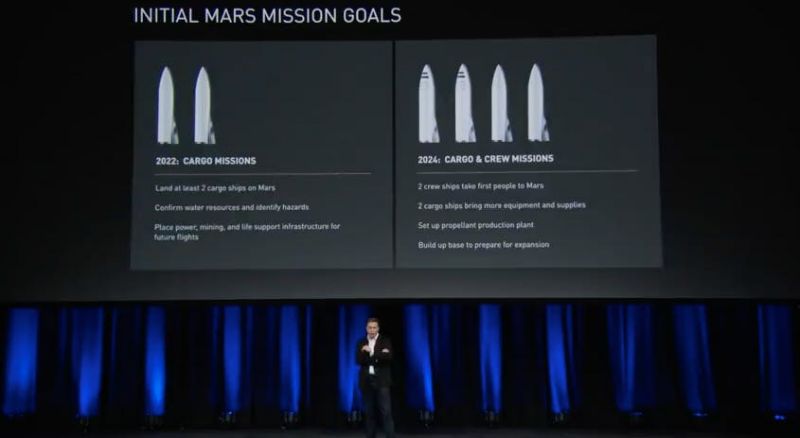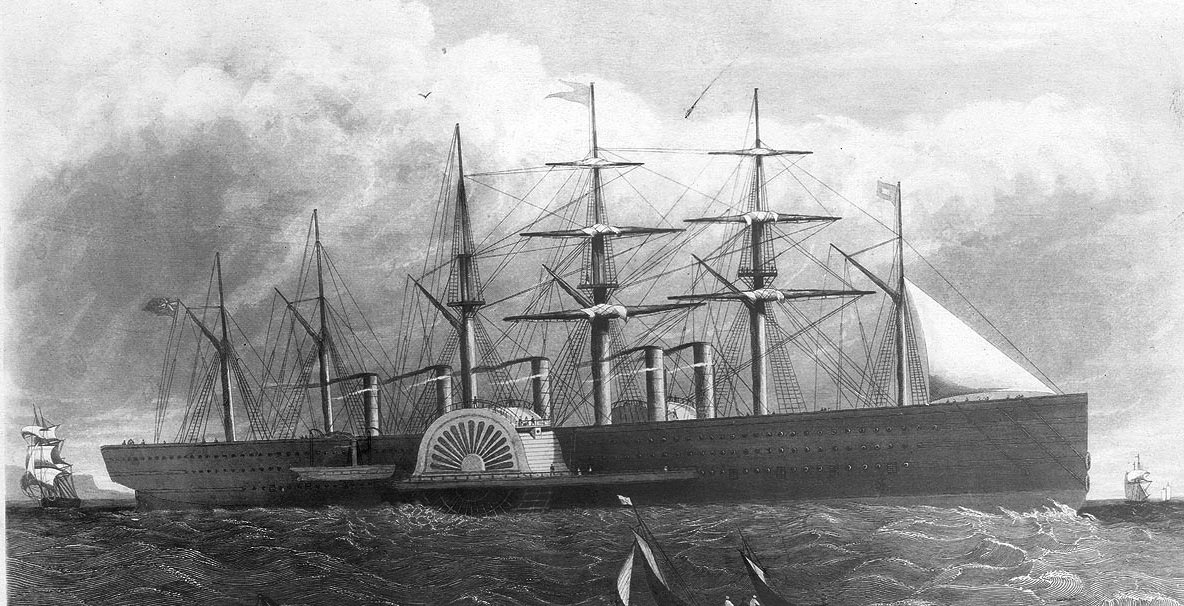= ASTRONAUTICAL EVOLUTION =
Issue 137, 1 October 2017 – 48th Apollo Anniversary Year
| Site home | Chronological index | About AE |
Elon Musk’s “Great Martian”
This year Mr Elon Musk is calling his giant Mars booster and spacecraft the BFR – the “Big (your choice of adjective beginning with F ) Rocket”. I think it should be called the Great Martian.
In order to assess its chances, we need to touch base with a little aviation and maritime history.
Comparison with the air travel industry
Between 1960 and 1999, air passenger traffic (numbers of passengers times distances travelled) increased at almost 9% per year, a factor of 2.4 above the rate of increase of global average GDP. Air freight also increased over the same time period at an average of around 6% per year – growth rates described as “dramatic” by Ben Daley in his recent book Air Transport and the Environment (Routledge, 2016).
Daley identifies the trends that have driven this growth: general economic growth, globalisation, and the expanding tourism industry. He makes the point that while air transport has been important in facilitating globalisation, globalisation has in turn increased demand for air travel – the classic self-stoking cycle.
What clues do these facts offer for the settlement of Mars?
Space travel is broadly comparable to air transport in terms of technology: both are fuel-intensive and highly computerised, require high-tech construction and propulsion, and carry crew and passengers through remote regions in sealed cabins with a life-support system. (Modern passenger jets fly at 11 km altitude, above the level at which unprotected human life is possible – in this limited sense, millions of people every day are almost astronauts and think nothing of it.)
There are also, however, major differences, particularly when voyages to Mars are being contemplated. In terms of time taken, such journeys are more comparable to emigrant voyages to Australia in the age of sail. The existing base of manned spaceflight is many orders of magnitude smaller per year than the level of air travel in 1960. And the destination needs to be supplied with habitable infrastructure before anyone can live there, either temporarily as a tourist or permanently as a settler – whether they are to occupy a space hotel in Earth orbit or a surface base on the Moon or Mars.
The market for travel to Mars is currently purely theoretical, since the cost is infinite and the supply is zero. But one can see that a virtuous cycle could appear, in which the future provision of transport to Mars facilitates multi-globalisation (the economically viable settlement of Mars and other extraterrestrial locations), while multi-globalisation increases demand for transport to Mars.
It may be the case that circumstances conspire to drive forward a period of unparalleled growth, as was the case with the Apollo Moon-flights half a century ago. These might include a tipping-point of technological maturity for rocket vehicles and life-support systems, an economic tipping-point in which the price of personal access to space falls for the first time within the means of a substantial fraction of the global middle-class population (like public access to supersonic travel in Concorde), a wave of public excitement about the infinite future possibilities open to a spacefaring civilisation, and/or a wave of public existential angst about the sustainability of one-planet civilisation on Earth.
To these must be added the point that a small industry is easier to grow than a larger one – it is easier to double a flight rate of 2 passengers/year to 4 than it is to double 2000 passengers/year to 4000, let alone two million to four million.
While such forces would accelerate the symbiotic growth of an Earth-Mars transport industry and a habitable Mars settlement, other forces would act as a brake. These notably include the novel stresses of the alien environment on Mars, the necessity of developing for the first time in human history a mode of urban life permanently enclosed within a low-buffer bubble of air, the extreme remoteness of the destination, its lack of material product valuable enough to be shipped back to Earth at a profit, the high cost of any space transport system relative to the earning potential of an average middle-class global citizen, and the social and political pressures towards reducing consumption and preserving wilderness areas, including those on other planets, in their original state.
Guesstimating the future of the space travel industry
With these points in mind, we can take the current space passenger transport industry of 12 individuals per year (excluding China), and extrapolate it into the future at various possible growth rates. Remember that these will be average, long-term growth rates, sustained if necessary over decades.
We shall see how long it takes, starting from the year 2017, before we are ready to fly one single 100-passenger spacecraft per year of the type described by Elon Musk, and how long it takes to fly 250 of these vehicles per year, thus 50,000 people per two-year Earth-Mars synodic period, leading to a Mars settlement of one million people in 40 years of flight activity, and assuming no other manned spaceflight activities are taking place (except for those in China and other countries operating independently of the American-European world).
| Growth rate | Time to arrive at 100 space travellers/year, and calendar year | Time to arrive at 25,000 space travellers/year, and calendar year |
| 5% per annum | 43 years: 2060 | 157 years: 2174 |
| 10% per annum | 22 years: 2039 | 80 years: 2097 |
| 20% per annum | 12 years: 2029 | 42 years: 2059 |
| 50% per annum | 5 years: 2022 | 19 years: 2036 |
| 100% per annum | 3 years: 2020 | 11 years: 2028 |
However one cuts it, it’s obvious that Elon Musk is pushing an aggressive timescale. The record of Falcon 9 launches over the years from 2012 to the present might offer some grounds for hope: from 2 successful launches in 2012 (one of which lost, however, a secondary payload) to 13, possibly as many as 20, by the end of 2017, represents about a 50% per annum growth rate.
If numbers of launches per year can be translated to numbers of space travellers per year, and if SpaceX vehicles can quickly take over the human traffic to the ISS, then this record would be consistent with two 100-person Mars ships in 2024 – Musk’s “aspiration” at his recent IAC talk – and a one-million population on Mars before 2080.
On the other hand, his plans are now dependent upon a rapid launch schedule using a reusable booster which is yet to be built – one that is significantly larger than the Saturn V (150 tonnes to LEO rather than 135 or so). The Falcon 9 growth record mentioned above begins with a flight-ready rocket (which flew in fact for the first time in 2010). A smooth transition from Falcon 9/Dragon to BFR seems to be the assumption, with none of the accidents which have dogged both Falcon 1 and Falcon 9, and none of the delays which have afflicted the upcoming Falcon Heavy, despite the BFR being innovative in more than just sheer size. Eyebrows may be raised at this prospect.
This year Musk proposed that his giant Mars booster would be supported by SpaceX’s commercial activities in near-Earth space. In principle this is definitely the right way to go. But in practice the Mars booster is too big at the current stage of development of the industry. It would be perfect for launching space hotels, for example, but such hotels would presuppose a traffic of at least thousands of fare-paying individuals to orbit per year.
Certainly, those passengers could be launched in Musk’s own spaceship on the same Mars booster, and for this use it wouldn’t even need any orbital refuelling. But the question then is: how quickly can such a large-scale industry be built up? Musk of all people must be aware of the many problems in developing a new vehicle – the seemingly simple design solutions which turn out to be a major headache in practice (his experience with the Falcon Heavy), the accidents and explosions which cause the total loss of a customer’s expensive satellite – or in the case of a passenger vehicle the loss of the customer him- or herself.
We are no longer living in the days when people wrote their wills before embarking on an Atlantic voyage. A high-profile failure with the deaths of a spaceshipload of people would be a major, very probably a fatal setback for Musk’s plans for colonising Mars – if not for his competitors.
In my opinion as an informed bystander, space passenger transport needs to grow slowly and carefully. Loss of 100 people in a disaster in a transport industry which carries a billion people a year is accepted. The same loss in an industry which carries only 100 people a year would be far more damaging.
Yet I congratulate Mr Musk on his vision and audacity. He is very much following in the footsteps of Isambard Kingdom Brunel, when he was building the Great Eastern. Yes, ships were eventually built as big as the Great Eastern, and even bigger, but only after a further 40 years of gradually increasing ship sizes and speeds. The Great Eastern itself was not a financial success, and – a word of caution to Mr Musk – it never made the voyage for which it was intended (England to Ceylon and Australia, as the name hints), though it did serendipitously enable the laying of the first transatlantic telegraph cables. It was not after all a short cut in maritime development.
Musk, like Brunel, may well have seen a little way into the future. But my prediction would be that SpaceX will find itself faced by many difficulties in developing a new super-Saturn-V-sized vehicle and spacecraft – Musk’s Great Martian – plus a new passenger spaceflight industry to keep its seats filled. Even when led by a man with an estimated net worth of $13.9 billion, I think the company will be forced to rely on the Falcon Heavy and on variations of the Dragon capsule, including the Red Dragon, if it is to continue making progress towards Mars by incremental steps rather than giant visionary leaps.
The crucial next steps – resuming services open to private fare-paying spaceflight participants (running at about one seat per year from 2001 to 2009) and removing reliance on the ISS as sole destination by placing the first commercial space hotels and laboratories in orbit – were not even mentioned by Musk in his talk, unless point-to-point transport on Earth (with its own special technical and regulatory challenges) is seen as a precursor. Until these steps have been taken there is no serious basis for talking of passenger flights to Mars. Realistic and sustainable growth rates for space passenger services, whether for tourists, explorers or emigrants, will surely struggle to match, let alone exceed, 10% per annum. Serious large-scale colonisation of Mars will not begin until towards the end of this century at the earliest.
Or Musk might just prove all his critics wrong and land 100 to 200 people on Mars in 2024!
Please send in comments by e-mail.
Interesting and relevant comments will be added to this page.
| Site home | Chronological index | About AE |

